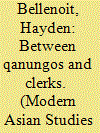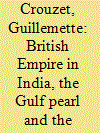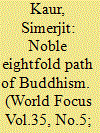|
|
|
Sort Order |
|
|
|
Items / Page
|
|
|
|
|
|
|
| Srl | Item |
| 1 |
ID:
132961


|
|
|
|
|
| Publication |
2014.
|
| Summary/Abstract |
This paper argues that our understanding of the transition to colonialism in South Asia can be enriched by examining the formation of revenue collection systems in north India between 1750 and 1850. It examines agrarian revenue systems not through the prism of legalism or landholding patterns, but by looking at the paper and record-based mechanisms by which wealth was actually extracted from India's hinterlands. It also examines the Kayastha pensmen who became an exponentially significant component of an Indo-Muslim revenue administration. They assisted the extension of Mughal revenue collection capabilities as qanungos (registrars) and patwaris (accountants). The intensity of revenue assessment, extraction and collection had increased by the mid 1700s, through the extension of cultivation and assessment by regional Indian kingdoms. The East India Company, in its agrarian revenue settlements in north India, utilized this extant revenue culture to push through savage revenue demands. These Kayastha pensmen thus furnished the 'young' Company with the crucial skills, physical records, and legitimacy to garner the agrarian wealth which would fund Britain's Indian empire. These more regular patterns of paper-oriented administration engendered a process of 'bureaucratization' and the emergence of the modern colonial state.
|
|
|
|
|
|
|
|
|
|
|
|
|
|
|
|
| 2 |
ID:
168365


|
|
|
|
|
| Summary/Abstract |
Genealogies of the term ‘Middle East’ conventionally focus on a juncture around the 1890s, when it gained new geopolitical currency, promoted by various European and American officials with reference to a space centred around the Arabo-Persian Gulf. This article argues instead that the ‘Middle East’ label should be seen as the culmination of a longer process, led less from London than from India. Over the previous century, this consolidation of ‘British’ India as a distinct regional actor was accompanied by the conceptualisation of its borderlands, including that Gulf-centred space. This space become a theatre for economic and political monitoring strategised from India, seeking to transform what was represented as a pirate-infested margin into a pacified buffer zone. Control and exploitation of pearl fisheries, the main economic activity for Gulf populations, was central to these efforts. Imperial strategy around the Gulf pearl was a key tool in founding an informal Indian empire in the Gulf and its hinterlands, in that very space to which the name ‘Middle East’ would subsequently be given.
|
|
|
|
|
|
|
|
|
|
|
|
|
|
|
|
| 3 |
ID:
130820


|
|
|
|
|
| Publication |
2014.
|
| Summary/Abstract |
When the society was on turmoil and the individual was in a state of fix on account of the prevalence of numerous views with regard to the different aspects of life, Gautarna, the Buddha made the world aware of an ethical means to get rid of suffering and the attainment of Eternal bliss. Buddhism originated in 6"' century B.C.E.' beneath the Bodhi-tree was disseminated by Siddehartha Gautam, the Buddha and his contemporary disciples in the different nook and comer of Ancient India 'for the good of the many, for the happiness of the many, out of compassion for the world". Later, the Indian merchants trading in the foreign lands, and the missionaries dispatched by the Mauryan King Asoka carried and introduced it beyond the frontier of ancient India, the land of its origin. It originated in the backdrop of spiritual unrest and intellectual ferment in the country. During that period the Brahmajalasutta records the prevalence of sixty-two views' related to the difference aspects of human existence while the Samafi?aphalasutta enumerates the views of six heretical thinkers - Pakkuddha Kaccana, Makkhali Gocala, Ajita Kesakambli, Purana Kassapa, Niganmha Namaputta, and Safijaya Velammhiputta', who were cotemporary to the Buddha. These views were, though conflicting in themselves, deeply rooted in the psyche of the people. Contradictions existing "in these views were perplexing the people and complicating their life. In no way these views were providing any comfort, peace and happiness to them. Rather, a natural question crept in their mind as to which of them was true, and how could one attain the eternal bliss?
|
|
|
|
|
|
|
|
|
|
|
|
|
|
|
|
|
|
|
|
|